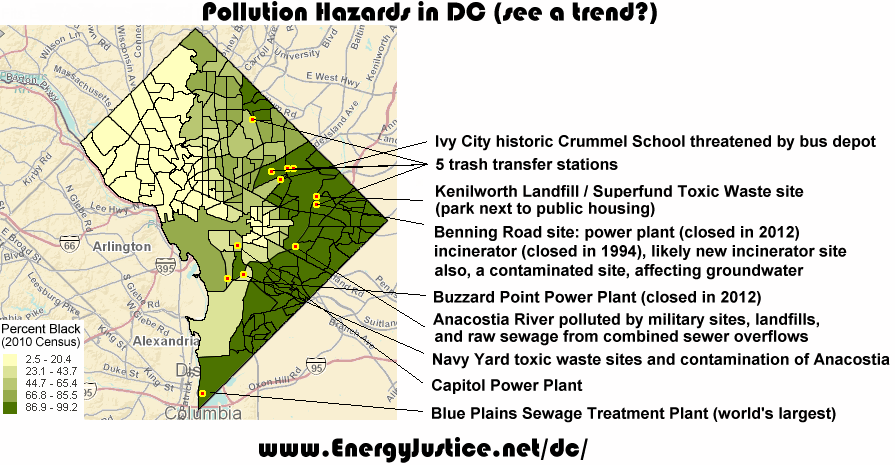DC Mayor and Council: Stop the Covanta Waste Incineration Contract! (Sept 2015)
VICTORY! DC Passes Styrofoam Ban and Bill to Boost Recycling and Composting! (July 2014)
Read about DC's Waste and Environmental Racism
Documents from our Freedom of Information Act (FOIA) requests to DC's Department of Public Works
Like our DC Environmental Justice Facebook page!

Environmental justice issues in DC:
Benning Road - hosted the city's trash incinerator from 1972-1994; hosted the oil-fired Pepco power plant that shut down in June 2012, leaving behind a toxic waste site around which is a current struggle over how the cleanup will go; hosts one of the city's two trash transfer stations, and around 2012-2013, was the only likely location for a new incinerator being considered by city officials. See our factsheet on trash incineration.
Kenilworth Landfill - right next to Benning Road site; Superfund site that National Park Service plans to "clean up" by dumping a couple feet of soil on it
Fort Totten - hosts the city's other trash transfer station
Brentwood and Langdon - hosts all three of the private trash transfer stations in the city: Federal IPC, Rodgers Brothers, and WMI Northeast.
Ivy City - current struggle against a planned bus depot; pollution from city maintenance vehicles
Blue Plains - hosts the world's largest "advanced" sewage treatment plant; the toxic sludge is dumped on farm fields in the region and some might be used to grow "energy crops" for burning as renewable energy
Navy Yard and numerous other locations - military toxic waste sites and buried munitions (even in the wealthy Spring Valley community)
Southwest / Buzzard Point – proposed DC United soccer stadium on toxic waste sites that won’t be fully cleaned up; proposed Pepco electrical substation adjacent to African-American community, to serve electric needs of gentrifying Waterfront neighborhood; Buzzard Point hosts the other main (oil-fired) Pepco power plant, also shut down in 2012, but not torn town like the one at Benning Road was; other noxious facilities in that SW DC neighborhood as well, including scrapyards and concrete facilities, and possible illegal waste burning
Capitol Power Plant - more upscale area, but close to low-income and communities of color - burning natural gas and coal; current campaign to stop the coal burning
Anacostia - combined sewer overflows affect the river, with raw sewage dumped into rivers when it rains (same for Potomac, actually, but the Anacostia gets most of the attention)
Unknown location - government/military nuclear research reactor somewhere in the city
City-wide - water fluoridation - toxic waste being added to the water, pretending it's good for teeth (it's not), but makes the lead in water problem worse and disproportionately affects black and Hispanic residents in terms of lead exposure
City-wide - energy policy - DC's renewable energy law supports many polluting technologies, like the burning of biomass, black liquor (toxic paper mill waste) and toxic landfill gases. The city gets it normal power from coal, nuclear and gas in the region, which is also a problem. A new gas-fired power plant to serve the region is targeting the black community of Brandywine, MD in southern Prince George's County. Also, fracking for natural gas is threatening the George Washington National Forest, which could contaminate DC's drinking water.
City-wide - waste policy - The largest recipient of DC waste is the trash incinerator in the community of color in Lorton, VA (Fairfax County). The city, as part of its Sustainable DC program, is conducting a $300,000 study of waste management options, with a heavy focus on "waste-to-energy" (incineration). See our article on DC's Waste and Environmental Racism
To get involved, contact Mike Ewall.
